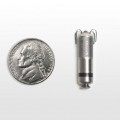
Clinical trial design. Cybersecurity. Big data. Those are a some of the 10 items on the U.S. Food and Drug Administration’s list of regulatory science priorities for medical devices in 2017, highlighted in a new report by the Center for Devices and Radiological Health.
Here are a some of the most interesting ones highlighted below:
Clinical trial design Plugging knowledge gaps between pre-clinical data and medical device clinical performance with better testing methods is another priority. The rationale for doing this is to better assess the impact of advanced materials and manufacturing, accelerated aging and the effectiveness of smart implant monitoring, the report said. Smart implant monitoring, in particular, has the potential to improve data on device performance and function to help clinicians do a better job of predicting failures.
The FDA would also like to re-visit clinical trials for medical devices in order to improve recruitment and better understand the safety and effectiveness of medical devices. The paper called for adaptive clinical trial designs and meta-analysis methods to establish non-inferiority margins, tools to determine the minimum number of subjects for rare diseases and novel methods for using placebo controls. These changes have the potential to streamline the device approval process and the success rate of medical devices.
Safety assessment With an eye to addressing safety profiles of implantable or patient-contacting medical devices, the regulator calls for modernizing biocompatibility and biological risk evaluation to avoid adverse events. The goal is to reduce healthcare costs and to give patients more rapid access to safer devices.
“New, less burdensome approaches that are more patient-centric and predictive of real-world device performance are needed to modernize and transform biocompatibility evaluation of medical devices and their materials,” the report noted.
Cybersecurity has been a hot issue in the medical device industry, particularly as the Internet of Things has made it easier for devices to de-silo and share data. Looking ahead to next year, the FDA wants to develop a standardized method to rate software vulnerabilities to include “the unique considerations of the healthcare environment,” according to the report. The regulator also called for studies to determine the categories of software modifications that could have negative effects on device safety or effectiveness.
Big data When it comes to applying big data to medical device design, the FDA has high hopes or delusions of grandeur, depending on your cynicism level. The health data sources it lists represent a wide and disparate range of outlets from “real-world experience, insurance, Medicare and Medicaid claims, clinical trials, imaging and next generation sequencing.” The priority should be to select the best artificial intelligence tools to make this data more manageable. That would clear the way to devote attention to improving medical device designs and developing precision diagnostics. Granted, the report suggested as much here:
“It is fundamental to develop the necessary infrastructure, statistical or analytical tools and models, information retrieval and processing for Big Data, relevant to enhancing safety, performance and quality of medical devices.”
Photo: Getty Images



